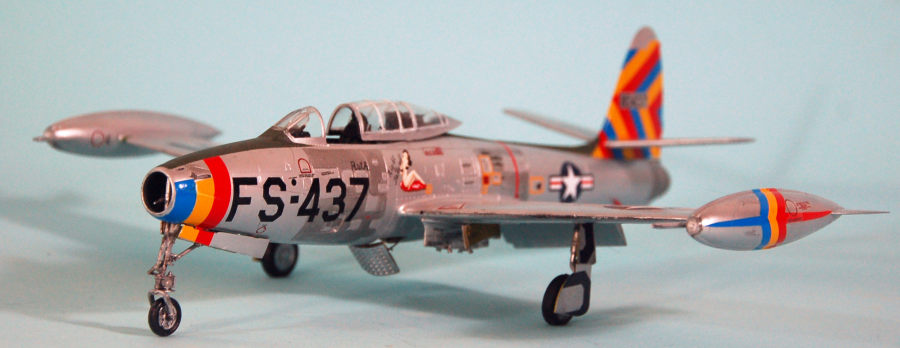
ProModeler 1/48 F-84G Thunderjet
| KIT #: | 5951 |
| PRICE: | $19.95 'used' |
| DECALS: | Two options |
| REVIEWER: | Tom Cleaver |
| NOTES: | Cutting Edge and Aeromaster decals |

| HISTORY |
The second Air Force jet fighter ordered into development, the F-84 was designed by Alexander Kartveli, who had created the P-47 Thunderbolt. After attempting a turbojet-powered replacement for the P-47, Kartveli and his team designed a new aircraft with a streamlined fuselage using an axial compressor turbojet, with fuel carried in thick unswept wings. After meeting with Kartveli, the USAAF released General Operational Requirements on September 11, 1944, for a day fighter with a top speed of 600 mph (521 kn, 966 km/h), combat radius of 705 miles (612 nmi, 1,135 km), and armament of either six 0.50 in (12.7 mm) or four 0.60 in (15.2 mm) machine guns, to be powered by the General Electric TG-180 axial turbojet, which entered production as the Allison J35.
The Air Force ordered three prototypes of the new XP-84 on Novemb er 11, 1944. Because the design promised performance superior to the Lockheed XP-80, and due to Republic’s extensive experience in producing the P-47, there was no competition for the contract. Republic chose the emotive name “Thunderjet,” to continue the tradition begun with the P-47 Thunderbolt, while emphasizing the new propulsion method.
The design ran into problems from the outset. The General Electric
turbojet was only producing some 3,000 pounds of thrust. Design weight escalated
when the airframe was beefed up after wind tunnel testing by NACA revealed
longitudinal instability and stabilizer skin buckling at high speeds. The
results of these tests were
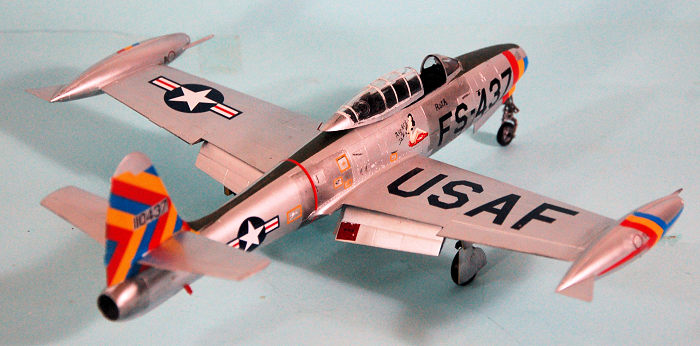 incorporated
in the third prototype, designated XP-84A, which used a more powerful J35-GE-15
engine that gave 4,000 pounds of thrust.
incorporated
in the third prototype, designated XP-84A, which used a more powerful J35-GE-15
engine that gave 4,000 pounds of thrust.
In January 1946, the first XP-84 took to the air for the first time at Muroc Field on February 28, 1946 with Major Wallace A. "Wally" Lien in the cockpit. In August, the second prototype arrived at Muroc. Both XP-84s were powered by J35-GE-7 engines producing 3,745 pounds of thrust. Fight tests revealed a limiting speed of Mach 0.80, which was quickly reached due to the thick wing. The Air Force now requested an increase in range for use as a bomber escort. Republic answered by developing jettisonable fuel tanks carried on the wingtip. The 15 YP-84As delivered for service test had the upgraded J35-A-15 engine first used in the third prototype, and were armed with a total of six .50-caliber M2 Browning machine guns, four in the nose and one in each wing root. They could carry wingtip fuel tanks with 226 U.S. gallons each.
The production F-84B differed from the YP-84A by having faster-firing M3 guns and became operational in December 1947 with 14th Fighter Group, based at Dow AFB outside Bangor, Maine. Within weeks, flight restrictions limiting maximum speed to Mach 0.8 due to control reversal, and maximum acceleration to 5.5 G due to fuselage skin wrinkling were issued. A shortage of partscreated maintenance difficulties and the new type earned the nickname "Mechanic's Nightmare." All F-84Bs were grounded on May 24, 1948, because of structural failures. This was quickly followed by the grounding of the F-84Cs just coming off the production line.
The newly-independent Air Force considered cancellation, but the
airplane was saved when the new F-84D, which entered service in early 1949,
satisfactorily addressed the major faults. The wings had a thicker aluminum
skin, a winterized fuel system capable of using JP-4 fuel was installed, and the
F-84D was powered by the more powerful J35-A-17D engine with 5,000 pounds of
thrust. Tests revealed the original wingtip fuel tanks contributed to structural
failure through induced excessive wing twist during high-G maneuvers; fitting
small triangular fins on the outer side of the tanks solved this. A fly-off
against the F-80 revealed that the Shooting Star had a shorter takeoff roll,
better low altitude climb rate
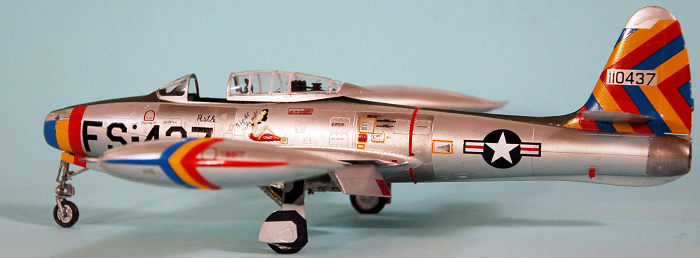 and superior
maneuverability, while the F-84 could carry a heavier bomb load and was faster,
with better high altitude performance and greater range.
and superior
maneuverability, while the F-84 could carry a heavier bomb load and was faster,
with better high altitude performance and greater range.
The F-84E was ordered December 29, 1948, and the first, 49-2022, flew on May 18, 1949. This was the first sub-type to completely fulfill the original specifications and resulted in a production run of 843. Powered by the same J35-A-17D used in the F-84D, the wing featured a redesigned, reinforced spar, while the fuselage was lengthened 12 inches ahead of the wings and three inches aft, which increased the fuselage fineness ratio and increased top speed while enlarging the cockpit and avionics bay, which required the canopy be ;lengthened 8 inches. The fuselage stretch allowed installation of a larger fuel tank. An A-1C gunsight with an APG-30 gunlaying radar fitted in the intake splitter plate improved gun sighting. Pylons inboard of the main gear well in the wing allowed carriage of a second pair of 230-gallon drop tanks, which increased the combat radius from 850-1,000 miles to 870-1,370 miles; alternatively, each inboard pylon could carry a maximum bomb load of 2,000 pounds, greatly increasing the aircraft’s capability in the fighter-bomber role it would eventually assume in Korea. Additionally, rocket racks which folded flush with the wing after rocket-firing reduced drag over the older fixed racks were fitted.
Despite these improvements, the F-84E’s in-service rate remained below 50 percent, primarily due to engine spares shortages. Allison production rates had originally been set on an expected individual aircraft flight schedule of 25 hours per month. Actual flight hours in Korea were at least double this and thus rapidly outpaced the initial supply and Allison's ability to produce new engines.
The “plank wing” F-84 began the pilot joke that “If they built a runway
that ran around the equator, Republic would design an airplane that would need
every foot to get off.” Pilot lore had it that F-84s were equipped with a
"sniffer" device that, upon passing takeoff speed, would se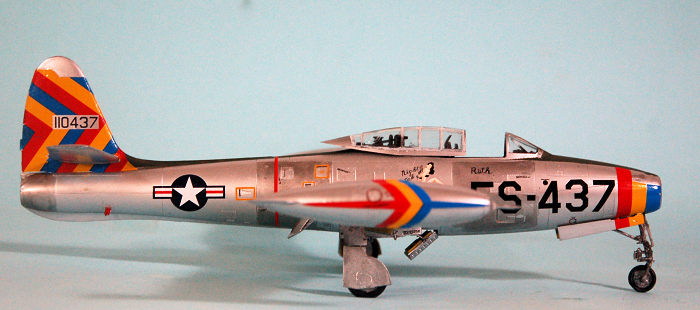 arch
for the dirt at the end of the runway. When the “sniffer” could detect the dirt,
the flight controls would come on and allow the pilot to take off. It was
suggested a bag of dirt be carried in the nose gear well. Upon reaching takeoff
speed, the pilot would pull a trigger that would dump the dirt under the wheels
and fool the sniffer.
arch
for the dirt at the end of the runway. When the “sniffer” could detect the dirt,
the flight controls would come on and allow the pilot to take off. It was
suggested a bag of dirt be carried in the nose gear well. Upon reaching takeoff
speed, the pilot would pull a trigger that would dump the dirt under the wheels
and fool the sniffer.
Thunderjet takeoff performance did leave much to be desired. During the hot Korean summer, with a full combat load, the F-84 routinely required all 10,000 ft of runway for takeoff, even using four rocket-assisted take-off (RATO) bottles, each providing 1,000 pounds of thrust for 14 seconds. In such conditions, all aircraft taking off after the lead had their visibility progressively obscured by the thick rocket exhaust smoke.
Because of its thick wing, the F-84 could quickly reached its Mach 0.82 limit at full throttle at low altitude . While the engine had not yet reached full power, exceeding the Mach limit at low altitude would result in a violent pitch-up and structural failure of the wings. The airplane could be flown faster above 15,000 ft, at the cost of severe buffeting. When engaged with the MiG-15, the speed limitation proved troublesome since the F-84 was slower than the MiG. With a maximum instantaneous turn load limitation of only 3 G, which was followed by a rapid loss of airspeed, the airplane could not turn tight enough to get away from an attacking enemy fighter. Jacob Kratt, the only F-84 pilot to score two victories in one fight, achieved his second victory by intentionally flying his F-84 into pitch-up. The pursuing MiGs were unable to follow the violent maneuver and one crashed. Luckily for Kratt, his airplane did not disintegrate but the airframe suffered such heavy warping that it was written off after he returned.
The definitive straight-wing F-84 was the F-84G which entered service in 1951. The aircraft introduced a refueling boom receptacle in the left wing as well as probes fitted to the inner side of the wingtip tanks for “probe and drogue” refueling, autopilot, Instrument Landing System, J35-A-29 engine with 5,560 lb of thrust, a distinctive framed canopy (also retrofitted to earlier types), and the ability to carry a single Mark 7 nuclear bomb. The F-84G was retired from the USAF Reserve and Air National Guard in by 1964.
| THE KIT |
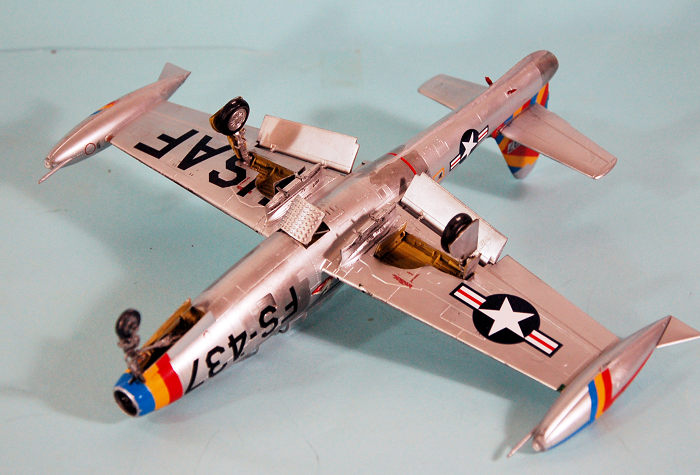 Monogram
announced their Thunderjet in early 1998, to be released through the company’s
ProModeler line. Unfortunately internal problems in the company resulted in the
first kit - the F-84G - not being released until 2000, which allowed Tamiya to
steal a march with that company's F-84G which was released in September, 1998.
Both the Monogram F-84G and later F-84E kits are superior in shape accuracy and
overall detail to the Tamiya F-84G kit, which is too deep in side profile, while
the ventral fin is too short, and the vertical fin and rudder are off in shape.
While the vertical fin shape can be modified (but not entirely corrected), the
other two items are unfixable. The Monogram kit is spot-on in fuselage shape.
Monogram
announced their Thunderjet in early 1998, to be released through the company’s
ProModeler line. Unfortunately internal problems in the company resulted in the
first kit - the F-84G - not being released until 2000, which allowed Tamiya to
steal a march with that company's F-84G which was released in September, 1998.
Both the Monogram F-84G and later F-84E kits are superior in shape accuracy and
overall detail to the Tamiya F-84G kit, which is too deep in side profile, while
the ventral fin is too short, and the vertical fin and rudder are off in shape.
While the vertical fin shape can be modified (but not entirely corrected), the
other two items are unfixable. The Monogram kit is spot-on in fuselage shape.
This particular kit had the typical poorly-printed and off-color decals associated with Monogram in is decline. I was fortunate to have the excellent Cutting Edge sheet that provided the F-84G “Night Take Off,” flown by Col. Charles Jordan, CO of the 58th Fighter-bomber Wing in July 1952. The sheet provided the colorful wing commander’s markings and personal markings, along with the “buzz” number and serial number. I was able to source the proper dark blue “USAF” decal from an Aeromaster sheet, and used the new Fundekals US National Insignia, which is excellent.
| CONSTRUCTION |
I started by painting the cockpit. The instructions say to paint it
Interior Green. However, looking at a color photo of the cockpit of the restored
F-84E at the Air Force Museum reveals it was Dull Dark Green, the same as the
P-47 cockpit. I thus used Tamiya “Black Green” which is a bit darker than Dull
Dark Green, with a bit of Tamiya “NAT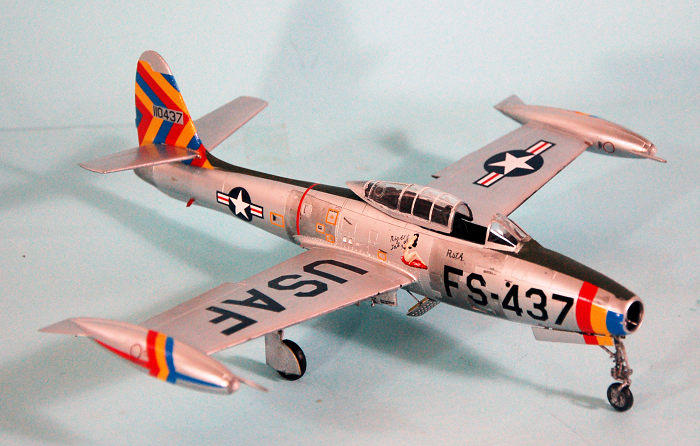 O
Green” mixed in. The instrument panel and the side panels were painted with
Tamiya Semi-Gloss Black with the detail “popped out” with a white color pencil.
I used Eduard photoetch US seat belts.
O
Green” mixed in. The instrument panel and the side panels were painted with
Tamiya Semi-Gloss Black with the detail “popped out” with a white color pencil.
I used Eduard photoetch US seat belts.
I assembled the nose gear well/intake splitter, painting it Yellow Zinc Chromate with Tamiya “Zinc Chromate,” a perfect match. I attached this assembly and the cockpit to the left fuselage half, then crammed some fishweighs above the gear well and below the cockpit to insure nose sitting. With careful assembly, there was only a minor centerline seam that was easily sanded off.
I assembled the wings, cutting off the inboard gear well door for later attachment after painting, and pained these gear wells YZC. I opted for the flaps-down version and assembled those for later attachment after painting.
The wings were attached then, and I left the horizontal stabilizers off for attachment after applying the large color decal to the vertical fin.
| COLORS & MARKINGS |
I misted on thinned Tamiya Gloss Black as the primer for the Vallejo
paints. The overall airframe was painted with Vallejo Aluminum. I then
hand-painted the Duraluminum panels on the forward and aft fuselage areas, and
used White Aluminum for various inspection panels. The ni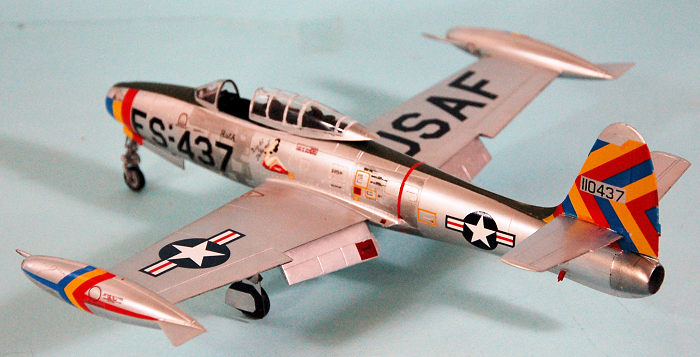 ce
thing about the Vallejo Paint is you can hand paint over it with other Vallejo
metallics, and there will be no brush strokes. Done this way, you do not need to
mask off these areas with the potential for pulling off the very thin paint.
ce
thing about the Vallejo Paint is you can hand paint over it with other Vallejo
metallics, and there will be no brush strokes. Done this way, you do not need to
mask off these areas with the potential for pulling off the very thin paint.
When it came time for decals, I started off doing the red-yellow-blue markings. This decal sheet was intended to fit the Tamiya kit, so there were some areas that were “off.” Fortunately, the Aeromaster sheet had some color panels that were the same shades as the Cutting Edge decals, and I used bits and pieces from those to “touch up” the short areas on the model. I then applied the service markings, followed by the stencils. The stencils came from the kit decals and were frankly terrible, taking a long time to come loose from their backing, and requiring Solvaset to make them sit down. I got enough of them on to simulate the stencil-intensive look of USAF fighters in the 1950s.
I assembled the landing gear and attached it, then the flaps. I unmasked the canopy and posed it in the open position.
| CONCLUSIONS |
The Monogram F-84s are still the best Thunderjet kits in 1/48, and can still be found on eBay at very reasonable prices. Aeromaster did a lot of decals for the F-84s and those can still be found. If you want a Thunderjet in your collection, either the Monogram (now Revell) F-84E or F-84G kits are the Thunderjets you want. Highly recommended.
7 March 2019
Copyright ModelingMadness.com
Project courtesy of my wallet.
If you would like your product reviewed fairly and
fairly quickly, please
contact
the editor
or see other details in the
Note to
Contributors.
Back to the Main Page
Back to the Review
Index Page
Back to the Previews Index Page